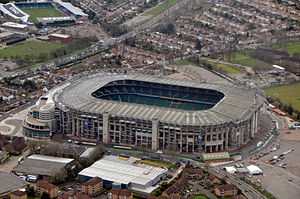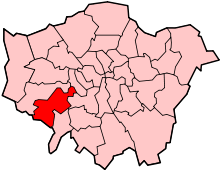Twickenham Stadium
|
Billy Williams' Cabbage Patch[1] The Cabbage Patch Twickers Headquarters The Tarquin Dome | |
 | |
|
Aerial view of Twickenham Stadium | |
| Location |
Whitton Road Twickenham England TW2 7BA |
|---|---|
| Coordinates | 51°27′22″N 0°20′30″W / 51.45611°N 0.34167°WCoordinates: 51°27′22″N 0°20′30″W / 51.45611°N 0.34167°W |
| Public transit | Twickenham railway station |
| Owner | Rugby Football Union |
| Executive suites | 150 |
| Capacity | 82,000[2] |
| Field size | 125 m x 70 m |
| Surface | Grass |
| Construction | |
| Built | 1907 |
| Opened | 2 October 1909 |
| Architect | Ward McHugh Associates |
| Tenants | |
| England national rugby union team | |
Twickenham Stadium (/ˈtwɪkənəm/; usually known as just Twickenham or Twickers[3]) is a stadium located in Twickenham, in the London Borough of Richmond upon Thames, south west London.
It is the largest stadium in the world devoted solely to the sport of rugby union, the 2nd largest stadium in the UK after Wembley Stadium and the 4th largest stadium in Europe.
The stadium is the home of the Rugby Football Union (RFU), and as such primarily a venue for rugby union and hosts England's home test matches, as well as the Middlesex Sevens, the Aviva Premiership final, the LV Cup, Heineken Cup matches and Barbarian F.C. home matches. The stadium is considered an icon of English rugby union and the 2009/2010 season saw Twickenham celebrate its centenary. The 100th anniversary of the first international at HQ in 1910 was marked by the England team wearing a special commemorative shirt against Wales on 6 February 2010 and by a centenary book called Twickenham – 100 Years of Rugby's HQ.
Although the ground is usually only occupied by rugby union, it has in the past hosted a number of other events, such as concerts by Rihanna, Iron Maiden, Bryan Adams, Bon Jovi, Genesis, U2, The Rolling Stones, The Police, Eagles, R.E.M. and Lady Gaga. It has also been the host of Rugby league's Challenge Cup final. The stadium has also been used annually for over 50 years to host Conventions of Jehovah's Witnesses.
Overview
Twickenham is often referred to as the home of rugby union.[4] The stadium is owned and operated by the RFU, so Twickenham is the host of numerous rugby union fixtures year round. Most prominently it is the home of the English rugby union team, who have played nearly all their home games at the stadium (as opposed to some of the other rugby nations that may have a home stadium, but use numerous venues, England uses just Twickenham). Twickenham hosts England's Six Nations matches, as well as inbound touring teams from the Southern Hemisphere, usually annually around November.
Apart from its relationship with the national team, Twickenham is the venue for a number of other domestic and international rugby union matches. It hosts the annual London leg of the IRB Sevens World Series as well at the domestic Middlesex Sevens competition. It is also the venue for the final of the Aviva Premiership as well as the season-opening London Double Header and the Christmas holiday Big Game, and has hosted the Anglo-Welsh Cup final in the past. Twickenham also hosted the 2006-07 Heineken Cup final. The stadium is also host to The Varsity Match between Oxford and Cambridge, the English schools' Daily Mail Cup final and the Army Navy Match which forms the culmination of the annual Inter-Services Competition.
History
Sold out Tests against New Zealand and South Africa at Crystal Palace saw the RFU realise the benefit of owning their own ground. Committee member William Williams and treasurer William Cail[5] lead the way to purchasing a 10 and 1/4 acre market garden in Twickenham in 1907 for £5,500 12s and 6d. The first stands were constructed the following year. Before the ground was bought, it was actually used to grow cabbages, and so Twickenham Stadium is affectionately known as the 'Cabbage Patch'. After further expenditure on roads, the first game, between Harlequins v. Richmond, was played on 2 October 1909 and the first international, England v. Wales, on 15 January 1910. At the time of the English-Welsh game, the stadium had a maximum capacity of 20,000 spectators. During World War I the ground was used for cattle, horse and sheep grazing. King George V unveiled a war memorial in 1921.
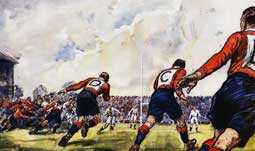
In 1926, the first Middlesex Sevens took place at the ground. In 1927 the first Varsity Match took place at Twickenham for the first time. In 1959, to mark 50 years of the ground, a combined side of England and Wales beat Ireland and Scotland by 26 points to 17.
Coming into the last match of the 1988 season, against the Irish, England had lost 15 of their previous 23 matches in the Five Nations Championship. The Twickenham crowd had only seen one solitary England try in the previous two years and at half time against Ireland they were 0–3 down. During the second half a remarkable transformation took place and England started playing an expansive game many had doubted they were capable of producing. A 0–3 deficit was turned into a 35–3 win, with England scoring six tries. This day also saw the origins of the adoption of the negro spiritual Swing Low, Sweet Chariot as a terrace song. In the 35–3 win against Ireland, three of England's tries were scored by Chris Oti, a black player who had made a reputation for himself that season as a speedster on the left wing. A group of boys from the Benedictine school Douai following a tradition at their school games sang Swing Low, Sweet Chariot whenever a try was scored. When Oti scored his second try, amused spectators standing close to the boys joined in, and when Oti scored his hat-trick the song was heard around the ground.[6][7] Since then Swing Low, Sweet Chariot became a song to sing at England home games,[8] in the same way that Fields of Athenry is sung in Dublin and Cwm Rhondda is sung at Cardiff.

The United Kingdom, Ireland and France shared the hosting of the 1991 Rugby World Cup. Twickenham was used during pool A England matches. Twickenham was also host of the 1991 Rugby World Cup Final in which Australia beat England 12-6. For this game, England changed their style of play, opting for the sort of running-game that had brought them victory against Ireland in the March 1988 game referred to above. During this match, with the English facing a 12 to 3 deficit, David Campese reached one-handed for a ball thrown to England winger, Rory Underwood. He dropped it and the ball rolled forward gifting England a penalty that proved the last score of the game. Some have claimed that Campese's action should have been interpreted as a deliberate professional foul with possible disciplinary action against the Australian player. However, on the same ground in November 1988, Campese had intercepted a similar pass and run the length of the field to score a try.[9]
Some of the Welsh-hosted 1999 Rugby World Cup games were taken to Twickenham. These included three of England's pool B matches, the second round playoff where England defeated Fiji 45 points to 24, and both semi-finals, none of which England were involved in, having made their exit in the quarter-finals at the hands of South Africa. Under the reign of Clive Woodward, the stadium became known as 'Fortress Twickenham', as England enjoyed a run of 19 unbeaten home matches from October 1999, ending with defeat against Ireland in 2004. The IRB Rugby Aid Match was played on 5 March 2005 under the auspices of the International Rugby Board (IRB) to raise money for the United Nations World Food Programme to support its work aiding victims of the 2004 Indian Ocean tsunami. Representative sides of the Northern and Southern hemispheres played at Twickenham. The final score was Northern Hemisphere 19 – Southern Hemisphere 54.
Redevelopment
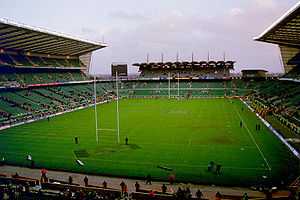
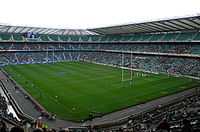
Since the ground was bought by the RFU in 1907, it has gone through a number of redevelopments. In 1921 a stand was built above the northern terrace, with workshops placed underneath. In 1927, there was an extension to the East Stand, bringing the capacity to 12,000. The south terrace was also extended to allow 20,000 spectators. In 1932 a new West Stand was completed, providing offices for the RFU, who made the ground their home. In 1937, Middlesex County Council approved a scheme submitted by Twickenham Borough Council to widen Rugby Road due to it being inadequate for traffic.
In 1965, the South Terrace was closed due to structural failings. It was found to be cheaper to build a new stand as opposed to repairing the existing one; however, planning permission was refused, due to objection from local residents. Permission was granted in 1978. A period of extensive rebuilding took place during the early 1980s which continued through to the mid-1990s. In 1981 the South Terrace was rebuilt as the South Stand. After being taken down in 1989, an extended North Stand was opened in 1990. After the 1992 five nations, the stadium saw the development of the new East Stand and following that the West Stand. In 1995, the stadium was completed to accommodate 75,000 people in an all-seater environment.
Planning permission was sought in 2002 and received in December 2004 for a new South Stand to raise capacity to 82,000, together with a hotel and conference centre, with redevelopment commencing in June 2005. The RFU's revised application to build the new south stand at £80 million was unanimously approved by Richmond Council's planning committee on 2 December. As well as increasing the stadium's capacity to 82,000, the redevelopment introduced a four-star Marriott hotel with 156 rooms and six VIP suites with views over the field, a performing arts complex, a health and leisure club, open a new rugby shop and also increase the current function space. On Sunday 10 July 2005 the south stand was demolished to make way for the new development. The festivities that were planned for the implosion of this end of the stadium were cancelled in the wake of the 7 July terror attacks in the centre of London. The new seating was complete by 5 November 2006 for the England vs New Zealand game of the 2006 Autumn internationals series, in which England lost in a near-record defeat.
Other uses
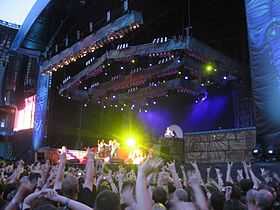
Though Twickenham usually only hosts rugby union fixtures, it has in the past been the venue for a number of other events. In 2000 the ground hosted its first game of rugby league, in which Australia defeated England in the opening game of the 2000 Rugby League World Cup. The Rugby League Challenge Cup Final has also been played at Twickenham twice and was won by St Helens on both occasions. Due to the construction delays of Wembley, a number of scheduled events at Wembley were moved to Twickenham. The Challenge Cup and the Rolling Stones' A Bigger Bang Tour concerts were taken to Twickenham.[10] The Stones also played two shows at Twickenham in August and September 2003, the first of which was used as their stadium concert disc for the 2003 DVD Four Flicks. During 2007 Genesis played at Twickenham during their "Turn It On again" World reunion Tour. The Police played at the stadium in September 2007 and Rod Stewart in June. The usual capacity for concerts is anything up to 110,000, as opposed to the 82,000 for rugby.[11]
R.E.M. performed at Twickenham in August 2008, while New Jersey rockers Bon Jovi played two gigs at the stadium in June 2008 as part of their Lost Highway Tour, and Iron Maiden played there as part of their Somewhere Back in Time World Tour on 5 July 2008, along with a full supporting bill which included Avenged Sevenfold, Within Temptation and Lauren Harris.
Since the mid-1950s it has also hosted the Jehovah's Witnesses annual convention for the London area. Usually up to 25,000 attend to hear Bible talks.
The TV motoring show Top Gear used the pitch for a match of rugby, played using Kia cars.[12]
Lady Gaga performed two sold out shows at the stadium during her Born This Way Ball Tour on the 8th and 9th of September 2012 with 101,250 people attending for both shows. The first date broke a record for The Fastest Selling-out Stadium Show in UK history when the 50,625 tickets for the first show sold out in 50 seconds.
Rihanna performed two shows at the stadium during her Diamonds World Tour on 15 and 16 June 2013 for 95,971 people for both nights and is, to date, the youngest person to ever headline shows at the stadium.
Concerts
| Concerts at the Twickenham Stadium | |||
|---|---|---|---|
| Date | Artist | Tour | Attendance |
| 24 August – 20 September 2003 | Rolling Stones | Licks Tour | – |
| 18–19 June 2005 | U2 | Vertigo Tour | 110,796 |
| 17 June 2006 | Eagles | – | – |
| 20–22 August 2006 | Rolling Stones | A Bigger Bang Tour | 100,540 |
| 30 June 2007 | Rod Stewart | – | – |
| 8 July 2007 | Genesis | Turn It On Again: The Tour | – |
| 27–28 June 2008 | Bon Jovi | Lost Highway Tour | 92,852 |
| 5 July 2008 | Iron Maiden | Somewhere Back in Time World Tour | 55,000 |
| 30 August 2008 | R.E.M. | Accelerate Tour | – |
| 8–9 September 2008 | The Police | The Police Reunion Tour | 104,417 |
| 8-9 September 2012 | Lady Gaga | Born This Way Ball | 101,250 |
| 15–16 June 2013 | Rihanna | Diamonds World Tour | 95,971 |
World Rugby Museum
The World Rugby Union Museum is a museum located in Twickenham Stadium. The museum covers the whole of the global game, not just English rugby union. It tells the history of the sport, including William Webb Ellis and Richard Lindon, using interactive display techniques. The museum has a rolling programme of special exhibitions which cover topical issues and offer an opportunity to display some of the obscurer items in the collection. Some unique displays include an English rugby union jersey from the first ever rugby union international in 1871 between England and Scotland, and (until 2005) the William Webb Ellis Cup which was obtained by England at the 2003 Rugby World Cup. Twickenham Stadium Tours are also available through the Museum and run four times per day (Tuesday to Saturday) and twice on Sundays. It is usually open every day of the week except for Mondays. Except match days when for ticket holders only a special price entry to the museum is available.
See also
- Rugby union in England
- Sport in London
- Twickenham Streaker (disambiguation)
References
- ↑ "The Rugby ground : The Twickenham Museum". twickenham-museum.org.uk. Retrieved 15 April 2010.
- ↑ "Twickenham Stadium". Rugby Football Union. Retrieved 7 January 2014.
- ↑ Nicky Campbell Twickers learning from us Scots as petty tyranny crosses border, The Guardian 1 February 2007
- ↑ RFU press office Home of Rugby to host cycling charity challenge 8 September 2006
- ↑ "Cail, William". 20thcenturylondon.org.uk. Retrieved 10 December 2011.
- ↑ Oliver Price Blood, mud and aftershave in The Observer Sunday 5 February 2006, Section O is for Oti
- ↑ "The story behind "Swing Low Sweet Chariot" and how it became a rugby anthem.". everyhit.com. Retrieved 8 October 2007.
- ↑ Tom Geoghegan, All you need to know about rugby: Rugby songs and jokes, BBC news magazine, 19 October 2007
- ↑ "1991: Wallabies pip England". BBC. 24 September 2003. Retrieved 19 August 2006.
- ↑ "Stadium delay hits Wembley gigs". BBC. 31 March 2006. Retrieved 24 September 2006.
- ↑ "RFU apply for two additional concerts at Twickenham Stadium in 2007". The Twickenham Rugby Stadium. Retrieved 21 March 2007.
- ↑ "Six Nations 2013: Top Gear team play car rugby". BBC Sport. BBC. Retrieved 18 February 2013.
Further reading
- Harris, Ed, (2005). Twickenham: The History of the Cathedral of Rugby, Sports Books, (ISBN 1899807292 )
- Spragg, Iain, (2010). Twickenham – 100 Years of Rugby's HQ, Vision Sports Publishing, (ISBN 9781905326761 )
External links
| Wikimedia Commons has media related to Twickenham Stadium. |
| Preceded by Eden Park Auckland |
Rugby World Cup Final Venue 1991 |
Succeeded by Ellis Park Johannesburg |
| Preceded by Lansdowne Road Dublin |
Heineken Cup Final Venue 1999-00 |
Succeeded by Parc des Princes Paris |
| Preceded by Lansdowne Road Dublin |
Heineken Cup Final Venue 2003–04 |
Succeeded by Murrayfield Edinburgh |
| Preceded by Millennium Stadium Cardiff |
Heineken Cup Final Venue 2006–07 |
Succeeded by Millennium Stadium Cardiff |
| Preceded by Eden Park Auckland |
Rugby World Cup Final Venue 2015 |
Succeeded by TBA |
